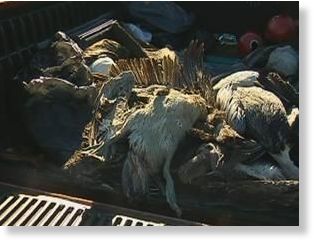
© WWAY YV
Necropsies in the fall of 2010 performed at the University of Georgia on the first group of Brown Pelicans were inconclusive as to cause of injury though there was no evidence of toxicological causes such as poisons. The newly found birds have also been sent to the university for analysis.
This recent incident involves about 30 pelicans that washed up on the shores either dead or so badly injured that they had to be euthanized. In an interview with WNCT-TV, Toni O'Neil of the Possumwood Acres Wildlife Sanctuary commented on the injuries to one bird "...
[it] looks like a bomb has gone off in the wing. It's that shattered and smashed so completely".
A taskforce, including officials from the National Oceanic and Atmospheric Administration and the U.S. Fish and Wildlife Service, as well as state officials, was formed to investigate the deaths, but so far has not determined a cause. The first dead birds began washing up on shore in November.
"Mass bird deaths such as this are certainly troubling and need to be investigated. According to the U.S. Geological Survey, about 160 mass wildlife death events are recorded in the U.S. each year. Sometimes they are weather related and sometimes they are caused by pollution, parasites, or diseases, but they frequently have a human component," said Dr. Moira McKernan, Director of the Pesticides and Birds Program at American Bird Conservancy, the nation's leading bird conservation organization.
"Certain types of injuries to pelicans such as broken beaks and gashes on the wings are consistent with post mortem scavenging by crabs or other animals, either in the water or onshore, and need not indicate deliberate wounding as a cause of death.
However, scavenging injuries would seem a much less likely cause in this case since a number of the birds were found still alive," she said."What is also significant is the number of bird deaths that go unreported or unrecorded each year because they each occur in smaller numbers and do not command media attention. These include deaths from pesticides and other toxins such as lead from spent ammunition, collisions with communication towers, buildings, or wind turbines, and free-roaming cats. Their cumulative impact, however, is significant, and may total more than one and a half billion birds each year," said Dr. McKernan.
The Brown Pelican is found along ocean shores from the Gulf Coast to the Chesapeake Bay, and in southern California. It is the only North American pelican that plunge-dives to catch its food. It may have a wingspan of up to seven feet and weighs about eight pounds. Following rapid and severe declines in Brown Pelican populations in the 1960s and '70s due to DDT use, the species was listed under the Endangered Species Act. After the DDT ban and concerted conservation efforts, the species recovered and was delisted in 2009.
Source: American Bird Conservancy (
www.abcbirds.org)
As both regional and international lawlessness continue to escalate, we are witnessing the earth, its climate, and its animal species go through "convulsions".
Yep, in a way, althought they haven't got souls, they are more connected to the Creator than us. We will witness the scary silence of all animals before the warning, next year.
In the End Times, ..."The beasts of the field, the birds of the air, and even the fish of the sea perish". The Book of Hosea 4:1-3